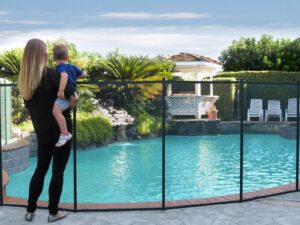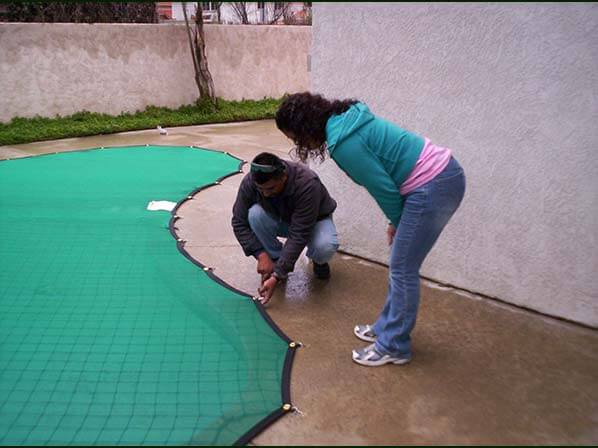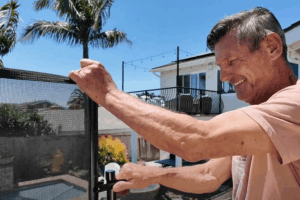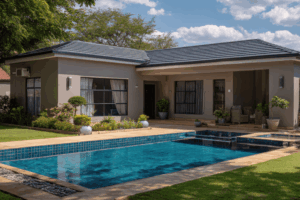
What Makes a Pool Fence Truly “Child-Safe”?
A truly child-safe pool fence does more than meet code. Discover the features parents should prioritize, and how All‑Safe builds fences that families trust.

Keeping your pool pristine and sparkling clean can be easier if you take the right approach. One thing all pools have in common is the need for routine and regular maintenance. Here are the top 10 basics of inground pool maintenance for this swimming season.
1. Clean Out Baskets And Skim The Debris
Use a skimmer to remove bugs, leaves or other debris often. Skimming significantly increases the overall efficiency of the pools circulation system and will lower the amount of chlorine your pool needs in the long run. You should also clean out strainer baskets at least once a week. Consider investing in a leaf pool cover to keep out the debris and make these other aspects of your inground pool maintenance even easier.

2. Brush Underwater Surfaces And Vacuum The Pool
A pool should be vacuumed every week so to keep the water clear. Make sure you check the filter of the pool vacuum every time you use it and clean it out if necessary. Brush the walls and tiles as well to minimize calcium deposits and reduce instances of algae build up.
3. Regularly Check And Maintain The Correct Water Level
A lot of water is usually lost throughout the summer season due to normal swimming. Some of it is also lost through evaporation. Check the water level often and ensure it doesn’t fall below the level of the skimmer. If the water level is low, use a garden hose to bring the level back up. An automatic pool cover can make your inground pool maintenance easier by helping to reduce evaporation, preserving your water and the effectiveness of your chemistry.
4. Maintain The Correct pH Level
You should make a point of testing your pool water to make sure it is healthy and clean. A pH reading between 7.2 and 7.8 is the ideal range for swimming and helps sanitizers work more efficiently too. There are several testing kits readily available; they are sold either as test strips or reagents. They are both easy to use. Alkalinity should be 80 to 120 ppm.
5. Check the In-deck Or Inline Chlorinator
This should be done at least once per week for a proper chemical adjustment. Proper levels of your sanitizer are important for many aspects of inground pool maintenance. Check the chlorine readings and ensure that they are within the acceptable standards. Ensure that the chlorine tablets are in the inline or in-deck unit and make the necessary adjustments to ensure proper chlorine levels.
6. Install A Removable Pool Fence
A removable pool fence adds an important layer of safety to your pool. It also helps to keep out unwanted animals, pests, and debris. Droppings and other materials from stray animals or even pets are rich in nitrates, which can act as food for algae in the pool. A pool fence prevents unauthorized access to the pool site, especially by children. A pool fence will not only make your inground pool maintenance easier by keeping your swimming area clean and tidy, but it can help reduce the chances of unintentional drownings too.

7. Clean Your Filters
Clean your pool filters every four to six months. It’s also good to check your filters after a heavy storm. The frequency you need to clean them is highly dependent on how frequently you use the pool and the prevailing weather conditions. For a thorough filter cleaning, soak them in a solution of Trisodium Phosphate (TP) or 10% solution of hydrochloric acid.
8. Shock Or Super-Chlorinate Your Pool
Organic contaminants such as nitrogen or ammonia, build up in a pool over time. Part of inground pool maintenance is cleaning them out. Such contaminants interact with the chlorine in the pool to form chloramines, which are known to create a potent and unpleasant chlorine-like smell. Shocking your pool can help make this undesired odor to go away. If you sanitize with an ozonator, you can also shock your pool by running your pump for twenty-four hours with the pools ozone system if you are on a 24-hour circulation.
9. Store All Chemicals Safely
Always keep all chemicals stored away from direct sunlight, make sure they are kept under lock and key. Never ever store any acid next to chlorine for whatever reason. When mixing acid and water, make sure you add acid to water and not the other way around.
10. Check For Cracks
Look out for cracks around the perimeter of your pool, especially between the tiles and the deck. Use beads of clear silicon to caulk gaps and spaces. Water should not be allowed to escape from the pool through these cracks.
Call An Expert
We hope these tips on inground pool maintenance were helpful! If you’re ready to make your pool a safer place for your family, contact your local All-Safe dealer for a free quote and consultation on effective pool safety barriers.

A truly child-safe pool fence does more than meet code. Discover the features parents should prioritize, and how All‑Safe builds fences that families trust.

Thinking of installing your own pool fence? Discover the benefits of DIY kits, from cost savings and flexibility to safety compliance, and how All‑Safe makes it possible.

Just got a pool? Learn what every new owner should know, from safety codes and barrier options to basic upkeep and seasonal preparation.
Enter your zip code to locate an independent installer in your area
Enter your zip code to locate an independent installer in your area
Enter in your zip code to let us know where your pool is located.
Due to the many variations in monitors, phones, and browsers, color samples and product examples may appear different on different screens. Computers and mobile devices are not all calibrated equally and color reproduction on the Internet is not precise. The same is true for printed items such as brochures and other sales literature.
In addition, the colors of our products photograph differently under different lighting conditions. For example, photos taken in full sunlight will vary from photos taken on a cloudy or overcast day. Similarly, shadows from nearby objects can affect the color and transparency of our products. If a precise color or specific shade is important, please inspect the actual color of your product prior to installation.
Many of our products’ materials are not available through typical stores and vendors and therefore must be custom manufactured specifically for our use. In order to control costs and provide you with the best value possible, our raw materials are produced in large batches and can often take several months to receive. The colors of our materials can, and often do, vary slightly from batch to batch. Although we make every effort to minimize color variations, we cannot be responsible for these differences when they occur. If a precise color or specific shade is important, please inspect the actual color of your product prior to installation.
For example, we use the name “putty” to describe some of our products. Your idea of the color “putty” may be different than someone else’s idea of “putty”. In addition, products may have the same color name but may not be the exact same color. For example, we have different shades of “black”. Please do not order using color names as your only guide. If a precise color or specific shade is important, please inspect the actual color of your product prior to installation.
If it is important that your product be an exact color or shade, it is highly recommended that you inspect the actual product prior to its installation and address any concerns with your local independent installer. Most independent installers do not offer refunds or accept returns due to color variations.